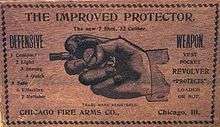Protector Palm Pistol
| Protector Palm Pistol | |
|---|---|
 | |
| Place of origin |
|
| Production history | |
| Designer | Jacques E. Turbiaux[1] |
| Designed | 1882 |
| Manufacturer |
Systeme E. Turbiaux, Chicago Fire Arms Co. Minneapolis Firearms Co. Ames Sword Company |
| Produced | 1882 |
| Number built | 3,000 Minneapolis Firearms Co., 12,800 Chicago Firearms Co./Ames Sword Company |
| Specifications | |
| Cartridge | .32 Extra Short |
| Caliber | .32 (8 mm) |
| Feed system | 7 or 8-round revolving magazine |
| Sights | none |
The Protector Palm Pistol is a small .32 rimfire revolver designed to be concealed in the palm of the hand. It was unique in that the revolver was clasped in a fist with the barrel protruding between two fingers and the entire handgun was squeezed in order to fire a round.
History
The Protector Palm Pistol was first patented and built in France in 1882 by Jacques Turbiaux and sold as the "Turbiaux Le Protector" or the "Turbiaux Disc Pistol". Later in 1883 it was built in the USA as The Protector by Minneapolis Firearms Co.. Peter H. Finnegan of Austin, Illinois bought the patent in 1892 and founded the Chicago Fire Arms Co. to make and market the pistols. In anticipation of the World's Columbian Exposition in 1893, he contracted the Ames Sword Company of Chicopee, Massachusetts to manufacture 15,000 pistols. Ames made 1,500 of the pistols by the deadline of the exhibition. Finnegan sued for damages and engaged in a lawsuit with Ames. The company countersued and settled with Finnegan, but, through the years, had amassed a large production run of 12,800 pistols. The company sold the inventory and abandoned the design by 1910.[2][3][4]
Remington manufactured the rimfire ammunition for this pistol, 32 Extra Short and alternatively 32 Protector, until 1920.[5]
Most Protectors were nickel-plated to prevent corrosion from being carried in close contact with the owner. These guns were shipped with hard rubber inserts for additional protection. Some varieties came with pearl inlays and a small percentage were blued.[1]
Operation
The design of these pistols was based on that patented by Jacques E. Turbiaux of Paris, France. Turbiaux described his pistol as "A revolver which may be held in the hand with no part exposed except the barrel".[6] The protector was designed to be the size of a pocketwatch and is a unique pistol in that it is not fired using a conventional trigger, but by the operator squeezing his or her fist when the pistol is in the hand.[7][8]
References
- 1 2 Flayderman, Norm (17 December 2007). Flayderman's Guide to Antique American Firearms and Their Values. F+W Media, Inc. p. 496. ISBN 0-89689-455-X.
- ↑ Taffin, John (2005). The Gun Digest Book of Cowboy Action Shooting: Guns Gear Tactics. Gun Digest Books. p. 92. ISBN 978-0-89689-140-1.
- ↑ Hogg, Ian; Walter, John (2004). Pistols of the World. David & Charles. pp. 14, 65. ISBN 0-87349-460-1.
- ↑ Shideler, Dan (14 April 2011). Gun Digest Book of Guns & Prices 2011. Iola, Wisconsin: Gun Digest Books. pp. 229, 623. ISBN 1-4402-1896-X.
- ↑ Barnes, Frank C. (22 September 2009). Cartridges of the World: A Complete and Illustrated Reference for Over 1500 Cartridges. Iola, Wisconsin: Gun Digest Books. p. 447. ISBN 1-4402-1330-5.
- ↑ Reid, William (October 1976). Arms through the ages. New York: Harper & Row. p. 236.
- ↑ Lee, Jerry (17 January 2012). Standard Catalog of Handguns. Iola, Wisconsin: Gun Digest Books. p. 105. ISBN 1-4402-3009-9.
- ↑ Worman, Charles G. (2005). Gunsmoke and Saddle Leather: Firearms in the Nineteenth-century American West. UNM Press. p. 520. ISBN 978-0-8263-3593-7.
External links
- Minneapolis Protector Palm Pistol
- Protector Pistol
- (Weapon No 259) Pistol .32 inch (Centre Fire) 'Le Protector'
- Chicago Firearms "Protector" Palm Pistol
- LE PROTECTOR SYSTEME E. TURBIAUX